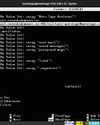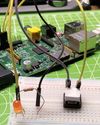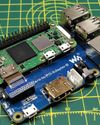Partitioning disks from the command line
Linux Format
|January 2021
Formatting and partitioning hard disk isn’t the exclusive domain of graphical tools. Shashank Sharma reveals the utilities that can make space for Linux.

Despite the constant push for user-friendly and intuitive graphical applications over the past decade, command-line utilities remain popular for performing a vast number of tasks. Whether its cloning your disk, transferring files across the network, communicating with peers, or even accessing social media, you can do it all from the relative comfort of the Linux shell.
Partitioning the hard disk, however, is one area where many users still prefer the point-and-click convenience of graphical tools. This is mostly because of lack of familiarity and not because the tools are lacking in abilities. In the late ‘90s and early 2000s, Linux users had to contend with only command-line tools to perform partitioning. In fact, fdisk is still the default, and it’s the only partitioning tool on some Linux distributions such as Slackware.
In this tutorial we’ll discuss all the functions you might have to perform to carve space on the disk for your distribution, such as creating and deleting a partition, and more. If you’re interested in learning whether partitions can be resized from the command-line too, refer to the Resizing Partitions box (below left).
The fdisk utility, along with many other tools, are part of the linux-utils package that’s part of the default installation on Linux distributions.
Not an expletive
The powerful fdisk utility can be used to create and delete partitions on the disk, so you must use it with extreme caution or risk losing all data on your disk. You can run the sudo fdisk -l
このストーリーは、Linux Format の January 2021 版からのものです。
Magzter GOLD を購読すると、厳選された何千ものプレミアム記事や、10,000 以上の雑誌や新聞にアクセスできます。
すでに購読者ですか? サインイン
Linux Format からのその他のストーリー

Linux Format
Create your first WebSocket service
Mihalis Tsoukalos explains how to use the Go programming language to work with the WebSocket protocol.
9 mins
April 2023

Linux Format
Fantastic Mr Firefox
Nick Peers takes a trip down memory lane to reveal the story behind the rise - and slight fall - of Mozilla's popular web browser.
9 mins
April 2023

Linux Format
Set up your terminal and email like it's 1983
Jump in the hot terminal time machine with Mats Tage Axelsson who emails from the command line using the latest technology.
8 mins
April 2023

Linux Format
Universal layer text effects with GIMP
Posters use them, films and presentations are hard to imagine without them: text effects. Attract attention with Karsten Günther and GIMP.
8 mins
April 2023

Linux Format
Jump to a federated social network
Nick Peers reveals how you can get up and running with this free, decentralised and non-profit alternative to Twitter.
9 mins
April 2023

Linux Format
Free our SOFTWARE!
Taking anything for granted is dangerous, so Jonni Bidwell and Mike Saunders revisit how the free software movement got started to help free us from proprietary tyranny!
4 mins
April 2023

Linux Format
Master RPI.GPIO
Les Pounder goes back to the early days of the Raspberry Pi - and his career with this classic library! -
5 mins
April 2023

Linux Format
Waveshare Zero to Pi3
Transform your Pi Zero into a Pi 3, they promised Les Pounder, but it's more like adding on go-faster stripes.
2 mins
April 2023

Linux Format
The Best OPEN SOURCE Software Ever!
In an attempt to trigger controversy, Michael Reed and Neil Mohr unequivocally state these are the greatest free software apps ever. Probably. We’re just trying to be helpful.
19 mins
April 2023

Linux Format
Linux-Mandrake 7
Simplicity and a wide range of applications make this a great distribution for all Linux users.
2 mins
April 2023
Translate
Change font size

